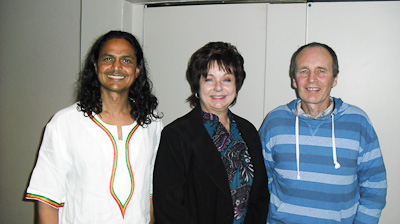 |
|
Pictured from the left, are: Prof. Dennis Francis (Dean), Prof. Rita Niemann (Director: Postgraduate Studies and Research) and Prof. Rob Pattman (Keynote speaker: UKZN).
|
No expert panels! No rubrics! Only a fair measure of healthy anxiety that goes with public speaking!
These features describe the meeting that staff members from the Faculty of Education recently had at Indaba Lodge on the banks of the Modder River. The purpose of this get-together was to create a time and space where staff members could not only celebrate their own research efforts, but also acknowledge, support and validate one another’s work.
The day kicked off with the dean’s research vision for the faculty. Thereafter seven staff members doing their Ph.D.s were introduced. Their presentations were followed by inputs from the guest speaker, Prof. Rob Pattman from the University of KwaZulu-Natal (UKZN). He congratulated the presenters on their cutting-edge research, their eloquence and the manner in which they managed to communicate complex matters in simple ways. Ideas he shared from his own research on social identities and critical agency (with a focus on gender and race) served to affirm the relevance of the topics presented by the Ph.D. candidates in transforming the education system as well as the South African society as a whole.
A festive lunch, in honour of retiring Prof. Johan van Staden, brought an affective dimension to the Indaba in the form of heart-felt goodbye messages from colleagues who had shared his academic life for more than 20 years.
After lunch five master’s students had the opportunity to share their research in the form of poster presentations. A lively interest among participants and critical, but constructive questions characterised this session. A potpourri session followed, comprising work in progress, completed surveys, research awards and innovative research methods.
The wrap-up by Prof. Dennis in no uncertain terms affirmed that researchers in the Faculty of Education not only crossed the Modder River, but also the proverbial Rubicon on 21 August. It was envisaged that henceforth:
- Supervision will take on a collaborative character.
- Soon a research forum for Ph.D. students and their supervisors will be established where these students and supervisors can start practising their agency.
- Instead of relying on outside experts who come and “tell” faculty staff members what to do, insiders should start building their own vibrant research-based practices by forming reading groups to discuss seminal works (e.g. Foucault and Freire) and research methodologies (e.g. Burke’s Pentad).
The Indaba was aptly concluded by one of the participants who, on behalf of all attendees, thanked and congratulated the dean on the initiative to give impetus to research. Analogous to the 2010 slogan, Feel it, it is here!, he said: “I feel so inspired and empowered, I can almost taste it!”